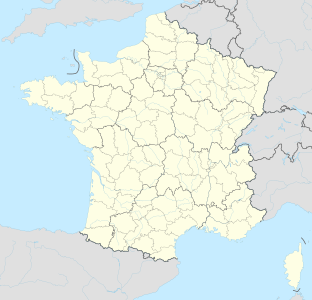Cussac Cave
| Cussac Cave
|
||
|---|---|---|
|
The entrance |
||
| Location: | Dordogne , Nouvelle-Aquitaine , France | |
|
Geographic location: |
44 ° 49 '47 " N , 0 ° 50' 53" E | |
|
|
||
The Cussac Cave is located in the French Dordogne department and contains more than 100 rock carvings from the Upper Paleolithic .
Location, description
The right bank of the Bélingou , a tributary of the Dordogne , has a rocky section in its middle course. This formation lies above a rapids over travertine . The entrance area is about 12 m deep and on average 3 m wide, whereby organic material was repeatedly removed in order to spread it on the surrounding fields as fertilizer. From there an 8 m long corridor leads to the foot of a scree hill. Behind it the corridor opens to a 10 to 15 m wide gallery, which is about 12 m high and has stalagmites . This room is unlikely to have been entered by humans in the last few centuries, so the site is undisturbed.
discovery
On 30 September 2000. Marc Delluc recognized that the cavers club of Périgueux belonged receipt. After squeezing through the narrow entrance, he was stopped by large amounts of rubble. After this obstacle had been partially removed, he was able to advance a further 100 m. At this point Delluc discovered the first engravings. He returned on October 7th, accompanied by Fabrice Massoulier and Hervé Durif. After the three men had discovered another 600 m gallery and other human traces, they finished their investigations so as not to damage the sensitive clay walls. The following day, Norbert Aujoulat from the Center National de Préhistoire and Christian Archambeau from the Direction Régionale des Affaires Culturelles carried out an investigation. The DRAC and the Service Régional de l'Archéologie have now started to classify them as sites of archaeological and historical importance. With the permission of the landowners on whose bottom the cave was located, this was done on November 23, 2000. In view of the fragility of the site, work was carried out in January and May 2001 to first remove the rubble that made the work difficult. After further safety measures, the recording and evaluation could be started.
Human remains
On May 21, 2000, the only human remains so far were discovered. These were spread over three sectors of the gallery on the left. At locus 1 , which was closest to the entrance, a round depression from a bear bed was discovered, in which there were bones that are not anatomically related. The sediment under some of the bones is colored with ocher . At locus 2 at the foot of the east wall, the almost complete skeleton of an adult was found in a further depression, which had probably been placed in the prone position. At locus 3 , bones of at least three adults were found scattered on an elevation, but no skull bones. In total, the bones come from at least five individuals. While loca 1 and 3 are disturbed, in locus 2 articulations indicate that there is an undisturbed find situation here. Since no diagnostic remains were found, the bones had to be dated directly. The age of locus 1 was determined to be 25,120 ± 120 BP, i.e. 29,500 to 28,835 years ago.
Scoring
In the meantime, over 100 carvings have been discovered in the cave known as the “Lascaux of the Art of Engraving”, many of them complete. These include mammoths , hippos , deer , bison and horses . There are also other species, which are otherwise very rare, such as birds, as well as idiosyncratic depictions with long beaks and open mouths. Fingerprints, female silhouettes and sexual representations complete the iconography. All representations, apart from a few finger drawings, are engraved, i.e. deepened. Cave bear scratch marks were older than human works.
The representations can probably be assigned to the Gravettian and thus around 28,000 to 22,000 years old. The assignment to the older Aurignacia is less likely . There may be similarities to wall carvings in the Quercy region, in particular with the Pech Merle Cave , so that a cultural connection is assumed here.


